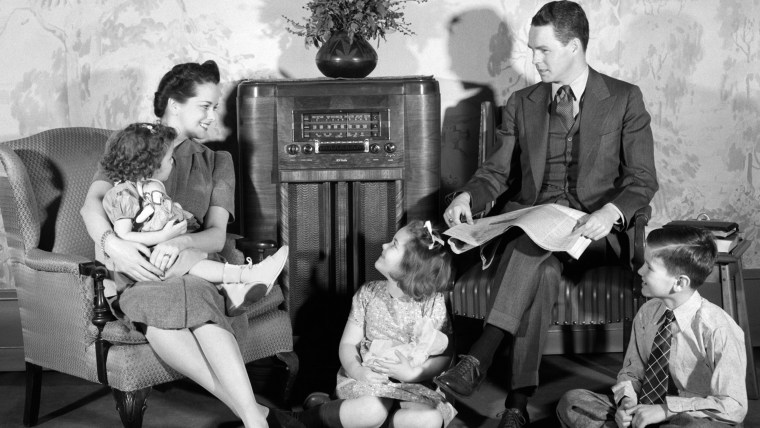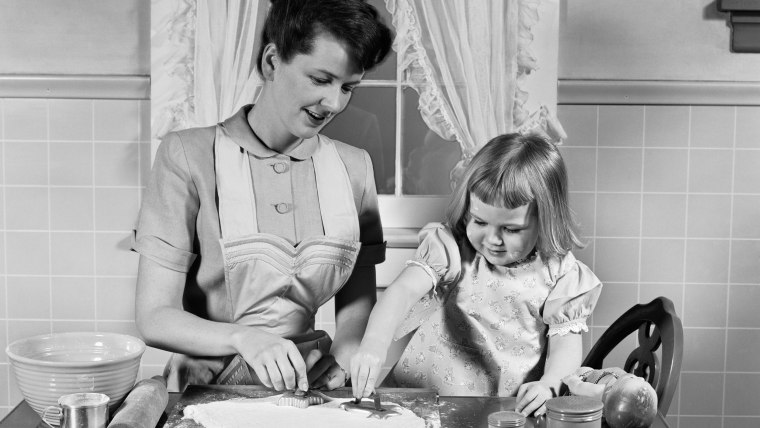
Mother’s Day might not have changed much since when you were a kid – perhaps breakfast in bed, a flower plucked from the garden and a gift made with more love than skill. But one thing’s clear: Motherhood itself looks very, very different.
While mom has always been there to bandage skinned knees, hang report cards on the fridge and help us through heartbreak, motherhood today has changed dramatically since 50, even 30 years ago.
“I think our standards have changed. One hundred years ago a parenting win was getting your child to live to adulthood,” says Dr. Deborah Gilboa, a parenting expert.
Fifty years ago, a mother might have smoked a cigarette while her kids sucked down the most scientifically advanced baby formula or climbed in the way, way back of the family station wagon without a seatbelt. While children are almost certainly better off now than they were back then, are moms? Along with advances in health and safety, the psychological pressures on moms seem to have multiplied.
That "Mad Men" era-mom wouldn’t have heard of “Mommy Wars,” and she almost certainly didn’t have Mom Guilt. She was much more likely to stay home with the kids, but – here’s a surprise – she also may have spent less time with them.
Mothers today are expected to bring home more of the family’s income, while keeping up with the lion’s share of the housework. Breastfeed – but not too long, lest you spark a national debate or at least encounter disapproving stares in public! Make the perfect, organic school lunch to post on Instagram. Create Etsy-worthy home crafts to keep up with the Mommy Bloggers. Be a Tiger Mom, or maybe a French Mom. Lean In.
Oh, but be sure to relax! Stop helicoptering. And put down that cellphone.
While some of these changes are hard to quantify, social scientists have been busily tracking other measures of motherhood. The statistics highlight how much has changed — and how some things about motherhood are timeless.
Hi-ho, hi-ho, off to work they go
1970: 40 percent of children had stay-at-home moms
2012: 20 percent of children had stay-at-home moms

Moms are much more likely to work full-time today than in previous generations. In 1970, 40 percent of children lived in a two-parent home where mom stayed at home. According to the Pew Research Center, in 2012 only 20 percent of children lived in a two-parent home with a stay-at-home mom.
There are many reasons for this change. Some women like Patti Barilla, 29, who had her first child, Luca, 15 weeks ago, enjoy their careers and say staying at home isn’t a consideration.
“I love my job too much. I couldn’t imagine not doing that. That was my first passion,” she says.
Barilla, who works as a first grade teacher at Pittsburgh Public Schools, believes her work hours will change — no more late nights of lesson planning at school. But she wants to balance her career with motherhood.
When Barilla was a child, her parents separated and her mother went to work. In the past, many working moms have also been single moms. And many families had to have both parents working to make ends meet. According to Pew, even in 1967, 51 percent of moms with kids under 18 worked outside the home.
“Our perception has changed more than the reality,” says Dave Riley, the Rothermel-Bascom Professor of Human Ecology at the University of Wisconsin-Madison.
Another simple reason more mothers in two-parent homes are working outside the house: Money. These days, two incomes are often needed to raise a family.
Barbara Stapleton, 32, wishes she could stay at home like her mother did. But the economic reality for her family, including 10-week-old son Ender, is that she has to go back to work.
“I’m dreading going back to work,” she says.
Breast is best
1971: 25 percent of women breast-fed
2013: 77 percent of women breast-fed
The "breast is best" message has been heard loud and clear over the past generation, to the point where many women now feel like they're under attack if they can't breast-feed. In 1971 only 25 percent of women breast-fed their children. According to the Centers for Disease Control and Prevention’s Breastfeeding Report Card in 2013, 77 percent of infants in the United States were breast-fed.
In the mid-20th century, people believed that using formula was healthier for babies and showed that a family was affluent.
“[People] believed that you only breast-fed if you couldn’t afford formula,” Gilboa says.
Today, many mothers feel like formula carries a stigma.
Stapleton says she did not produce enough milk and had to supplement with formula.
“I didn’t know it could be a problem where I did not make enough milk to feed my baby,” she says.
Barilla says that her mother breast-fed her, but stopped as soon as Barilla began eating solid foods. Barilla plans on breast-feeding for at least a year as pediatricians recommend.
Deena Blumenfeld’s mom tried breast-feeding for a few months, but after getting an infection, she stopped. She also added rice cereal to the bottle when Blumenfeld was 2 months old — a parenting trick that used to be common, but is now frowned upon.
“That made me take a deep breath,” Blumenfeld, 38, says via email. The mother of two, Owen, 9, and Elaine, 5, breastfed her kids until they naturally weaned themselves.
Spare the rod
1986: 82 percent of U.S. women agree that sometimes children need a "good, hard spanking."
2012: 65 percent of U.S. women agree that sometimes children need a "good, hard spanking."
Riley says that over the past few decades people self report that they are spanking less. But, he believes most American families still spank their children. Data on spanking can be fuzzy. A recent poll found that 22 percent of parents spank their children weekly.
According to Child Trends Data Bank, 77 percent of men and 65 percent of women in 2012 said children sometimes need a "good, hard spanking," a proportion that's been decreasing steadily over the past 20 years over a growing body of research showing that spanking and other physical punishment may be harmful in the long-term and doesn't actually work that well.
“My unscientific opinion is that American parents do spank less often today than 50 years ago,” Riley says. “I am in favor of minimizing or eliminating spanking, but I am even more in favor of parents learning other effective means of disciplining children.”
Blumenfeld’s mother spanked her, but she disciplines differently.
“Spanking is taboo in our house,” says the yoga and Lamaze instructor. She says she often lets her children make mistakes and helps them learn from them.
Sarah DeAngelis-Abbott’s mother spanked her and her brother. She washed their mouths out with soap, screamed, and grounded them for small infractions, DeAngelis-Abbott says.
“I try to avoid that as much as possible,” DeAngelis-Abbott, 35, says.
Instead of spanking, there is a large and sometimes bewildering menu of discipline methods for parents to choose — and a thriving industry of parenting-help books promoting different discipline philosophies, from "natural consequences" to "1, 2, 3 Magic."
DeAngelis-Abbott, a stay-at-home mom, says she grounds her children, Andrew, 15, Sean, 8, and Emillia, 4, but she tries to be patient and chat with them. Once, when Andrew’s classmate dared him to take Xanax, he talked to her about it, which made her feel like her approach is working.
“I don’t think I had a heart-to-heart with my mom,” she says.
The time warp
1965: Moms spend 10 hours a week on childcare
2011: Moms spend 14 hours a week on childcare
Moms are working more nowadays — but they're also spending more time with their kids. In 1965, the average was about 10 hours a week compared to 14 hours a week in 2011, according to a Pew survey. So working mom guilt about not spending time with the kids may be based on a mythical idea of the past, rather than reality. (What are we doing less of? Housework, the survey says.)
Dads' roles have changed dramatically, with fathers much more involved in hands-on child care and housework — though mothers still do the lion's share.
“Fathers are taking a larger role in the household,” Riley says. “When the family really need it, the men step forward and pick up the slack and then [fathers’] attitudes change.”
But negotiating those changing roles isn't always easy. A 2012 TODAY/Parenting.com survey of more than 4,000 parents found that while half of dads say they split child care evenly with their partner, less than a quarter of mothers agree. And a 2013 TODAY.com survey found that 46 percent of mothers say their husbands stress them out more than their kids! A more equal marriage doesn't necessarily mean a happier marriage: A recent Norweigan study found higher divorce rates among couples who split the housework evenly.
Both parents can put themselves through a lot of stress trying to be there for the kids while also earning enough to put a roof over their heads.
“In 10 percent of dual earner families the father and mother work two different work shifts so they can cover childcare. Great for the [parent/child] relationship but terrible for the marriage,” says Riley.
Mom vs. mom
1972: Free to be you and me
2014: Free to be... judged by the sanctimommies?
There isn’t much data on mom guilt or mommy wars, but we know they exist – or at least that we talk about them a lot. In another generation, those kinds of conversations weren’t happening – for good or ill.
“One of the things I find most interesting [is that] parents feel more willing to seek out resources” for parenting issues ranging from breast-feeding challenges to defiant teens, says Gilboa.
“In the ’50s and ’60s, if you had a problem you might talk to your mother, mother-in- law, or sister, but you wouldn’t really talk to your friends. It was considered shameful.”
Now, there are countless message boards and mommy groups to offer help to moms who might have suffered in silence a few decades ago. But along with the public support comes public judgment on a whole lot of parenting issues that no one seemed to care about in past generations.
“What we want for our kids is more broad than what we wanted 50 years ago,” says Gilboa. “I think our anxiety has increased and we have loftier goals and they are harder to achieve and really impact the conversation.”
Barilla says she sometimes feels judged. Yes, she is breast-feeding, which wins her approval from most people. But people seem to dislike it if she does it in public. She uses cloth diapers, but her friends and family wonder why she doesn’t use disposables when she leaves the house.
“It’s a little hard that there is so much that can be judged,” she says.
Gilboa says that social media makes it easier for people to critique others and make moms feel insecure about their own choices.
“Outwardly, we say we are a lot less judgmental, but we are a lot more willing to tell people how to raise their kids.”
Blumenfeld’s grandmother sometimes struggles to understand her granddaughter’s modern mothering choices. She told Blumenfeld that moms today are too overprotective; in the 1950s a little freedom didn’t hurt her kids. Her grandmother once told her, “We used to leave the baby in the stroller, parked outside the restaurant while we ate.”
Perhaps a little dose of the laissez-faire attitude of previous generations is exactly what today's mothers need. As Blumenfeld says, her grandmother may not have understood all the modern parenting issues she worried about, but she didn't judge: “Grammy was also supportive of most things.”